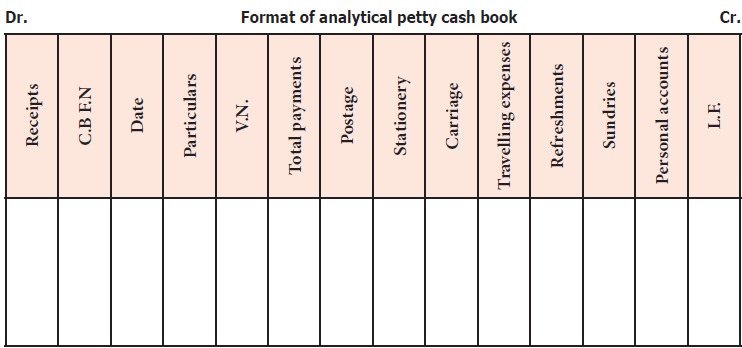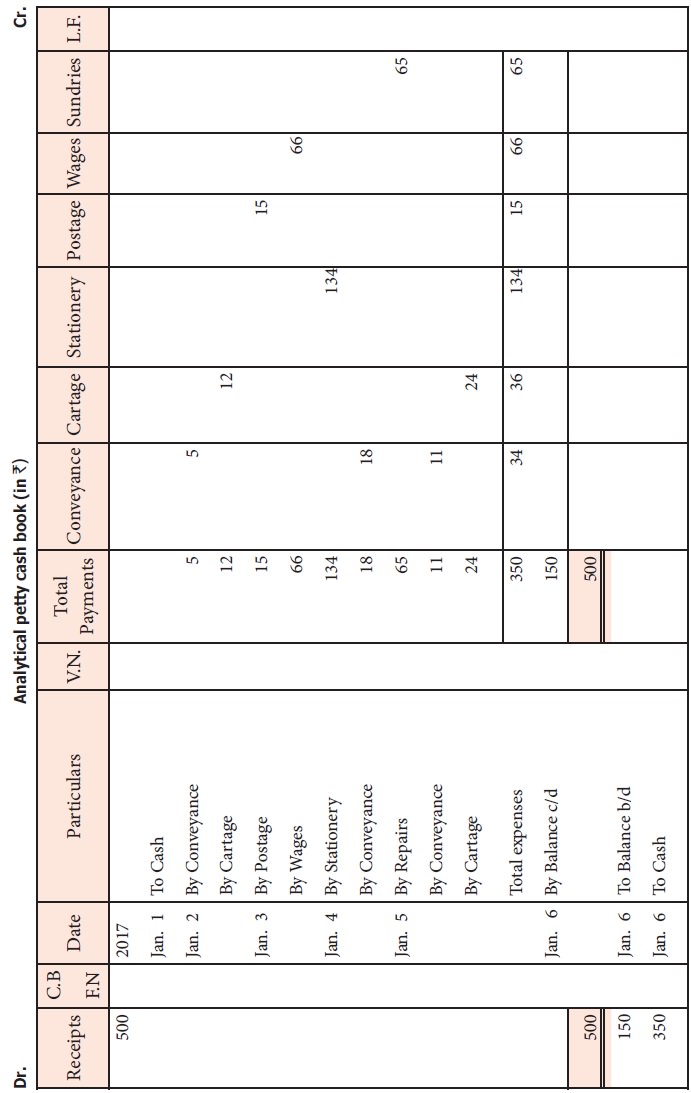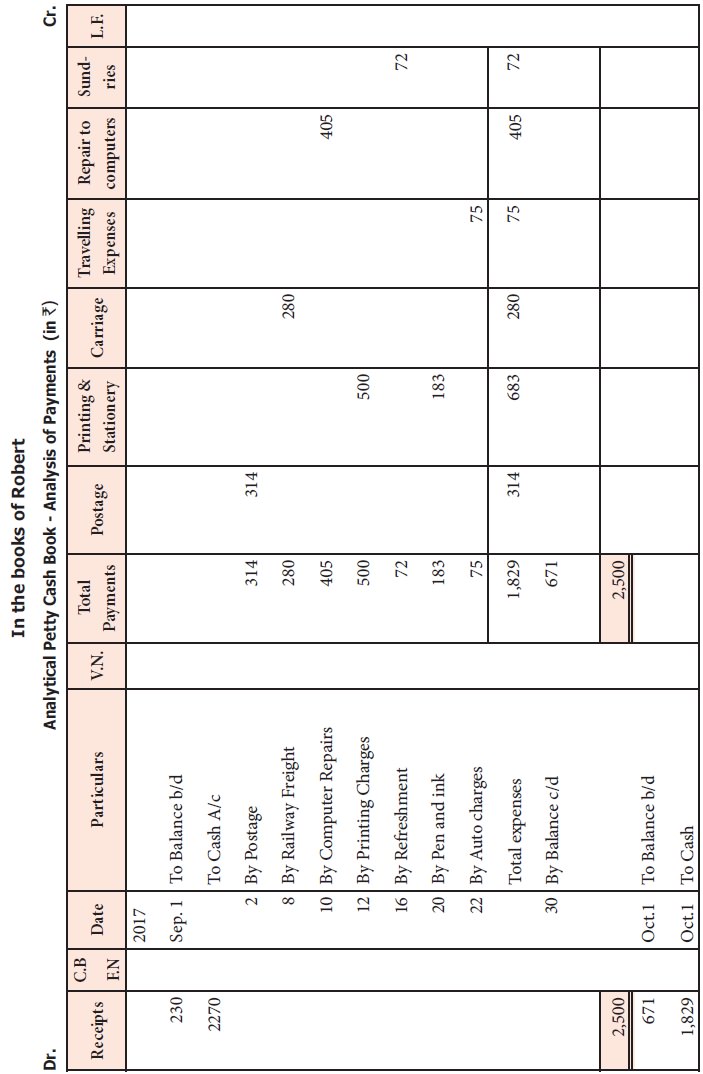Accountancy - Petty cash book | 11th Accountancy : Chapter 7 : Subsidiary Books - II Cash Book
Chapter: 11th Accountancy : Chapter 7 : Subsidiary Books - II Cash Book
Petty cash book
Petty cash book
Business
entities have to pay various small expenses like taxi fare, bus fare, postage,
carriage, stationery, refreshment and other sundry items. These are small
payments and repetitive in nature. If all these small payments are recorded in
the main cash book, it will be loaded with lot of entries. Hence, all petty
payments of the business may be recorded in a separate book, which is called as
petty cash book and the person who maintains the petty cash book is called the
petty cashier. Thus business concerns may maintain main cash book and petty
cash book separately.
All the small payments must be supported by
vouchers, that is, documentary evidences. The vouchers must be numbered and
filed in order. Petty cashier makes only cash payments. He must not be allowed
to receive any cash except for reimbursement. Petty cashier has to make
payments only within the specified limit. Payments involving large amounts must
be made only by main cashier. At the end of the relevant period, petty cash
book is balanced. Balancing of petty cash book is similar to the balancing of
simple cash book.
1. Imprest system of petty cash
Under this
system, a fixed amount necessary or sufficient to meet petty payments
determined on the basis of past experience is paid to the petty cashier on the
first day of the period. (It may be a week or fortnight or month). The amount
given to the petty cashier in advance is known as “Imprest Money”. The word
imprest means payment in advance. The petty cashier makes payments from this
amount and records them in petty cash book. At the end of a particular period,
the petty cashier submits the petty cash book to the head cashier. The head
cashier scrutinises the petty payments and gives amount equal to the amount
spent by petty cashier so that the total amount with the petty cashier is now
equal to the amount he had received in the beginning as advance. Under the
system, the total cash with the petty cashier never exceeds the imprest at any
time during the period. This method thus provides an effective control over
petty payments.
For example,
On 1st June, 2017, Rs. 1,000 was
given to the petty cashier. He had spent Rs. 940 during the month. He will be paid Rs. 940 on 30th June by the
cashier so that he may again have 1,000 for
the next month i.e., JuLy, 2017.
2. Advantages of maintaining petty cash book
Following are the advantages of maintaining petty
cash book:
i.
There can
be better control over petty payments.
ii.
There is
saving of time of the main cashier.
iii.
Cash book
is not loaded with many petty payments.
iv.
Posting
of entries from main cash book and petty cash book is comparatively easy.
3. Types of petty cash book
There are two types of petty cash books. They are:
i.
Simple
petty cash book
ii.
Analytical
petty cash book
(i) Simple petty cash book
A simple
petty cash book resembles the single column cash book. But the columns are
different. On the debit side, only the advance received from the head cashier
is recorded. On the credit side, all payments are recorded in only one column.
This is known as simple petty cash book.![]()
(ii) Analytical petty cash book
In analytical
petty cash book, a separate column is provided for different heads of payments
and one column for total payments. When the petty expenses are recorded in the
total payment column, same amount is also recorded in the appropriate expense
column. This is known as analytical petty cash book.

Details entered in the various columns of the petty
cash book are as follows:
1) Receipts
This is the
first column of the petty cash book. The amount received by the petty cashier
for meeting petty expenses is recorded in this column. Generally, amount is
received once on the first day of every week or month. The opening balance of
petty cash is recorded in this column as the first item. This column shows the
total amount available with the petty cashier.
2) Cash Book Folio Number (C.B.F.N.)
In this
column, the page number of the cash book in which the entry is made is
recorded.
3) Date
In this
column, the date of receipt of petty cash and payment of every petty expense is
recorded.
4) Particulars
The details
of transactions are entered in this column. Cash received in the beginning is
recorded as ‘To Cash A/c’ and all the petty expenses are recorded as ‘By
Concerned Expense A/c” (name of the expense).
5) Voucher Number (V.N.)
Every
transaction in accounting must be supported by documentary evidence. All the
payments must have vouchers which must be arranged in the chronological order
of payment and serially numbered. Voucher number of every payment is written in
this column.![]()
6) Total
The amount of
every petty expense is recorded in this column. At the end of the week or month
expenses are totalled. The total expenses of the week or the month is compared
with the total of the receipts column and balance is obtained.
7) Postage
Postal
expenses incurred for post card, envelope, inland letter, postage stamps,
registered letter, parcel, etc. are recorded in this column.
8) Stationery
It includes
expenses incurred for purchasing materials such as paper, ink, pencil, eraser,
carbon paper and other similar stationery items.
9) Carriage
It includes
amount paid as wages, transport charges and other expenses.
10) Travelling or conveyance expenses
In this
column fare for auto rickshaw, taxi, bus, train, etc., are recorded.
11) Refreshments
Amount spent
for tea, coffee, snacks, etc., is recorded.
12) Sundries
There may be
certain expenses which are infrequent for which specific columns are not
provided. These are recorded in this column.
13) Personal accounts
Small amount
of money paid to individuals are entered in this column.
14) Ledger Folio (L.F.)
This refers
to the page number of the ledger where the respective account is recorded.
4. Balancing petty cash book
At the end of
the period, i.e., week or month the total of the total column, individual
expenses columns and sundries columns, is obtained. The total of the individual
petty expenses column must be equal to the total in the total column. The sum
of the total column is compared with the total of receipts column and the
balance is obtained. The closing balance is shown as ‘By Balance c/d’. The
closing balance is carried forward to the next week or month. It is shown as
‘To Balance b/d’. Cash received from the main cashier at the beginning of the
next period is entered as ‘To Cash A/c’ and the amount is recorded in the
Receipts column.
5. Posting of entries from petty cash book to ledger
i. When petty cash is advanced at the beginning:
A separate petty cash account is opened in the
ledger. When advance is received by the petty cashier, petty cash account is
debited and cash account is credited.
ii. When individual expenses columns are
periodically totalled:
The total of various petty expenses are debited and the petty cash account is credited with the total of the payments made.
The petty cash account will show the balance of petty cash. This balance will be shown in the balance sheet as part of cash balance.
Tutorial note
Instead of debiting the total of each petty expense
directly, a separate journal entry may also be made and then credited to petty
cash account. The journal entries are:
For receiving petty cash:
Petty cash
A/c Dr.
To Cash A/c
For expenses paid:
Respective
expense A/c Dr.
To Petty cash
A/c
Illustration 8
Prepare a analytical petty cash book from the
following information on the imprest system:
2017 500
Jan. 1
Received for petty cash 5
Jan. 2 Paid rickshaw charges Paid 12
cartage 15
Jan. 3 Paid
for postage 66
Paid wages to casual labourer 134
Jan. 4 Paid for stationery Paid for 18
auto charges 65
Jan. 5 Paid
for repairs Paid for bus 11
fare Paid for cartage 24
Solution for illustration 8
Prepare a
analytical petty cash book from the following information on the imprest
system:
2017
Jan. 1 Received for petty cash 500
Jan. 2 Paid rickshaw charges 5
Paid cartage 12
Jan. 3 Paid for postage 15
Paid wages to casual labourer 66
Jan. 4 Paid for stationery 134
Paid for auto charges 18
Jan. 5 Paid for repairs 65
Paid for bus fare 11
Paid for cartage 24
Illustration 9
Prepare analytical petty cash book in the books of
Robert from the following transactions. 2017
Sept Rs.
1 Balance in hand 230
Received a cheque to make the imprest
amount 2,270
2 Postage 314
8 Railway freight 280
10 Repairs to computer 405
12 Printing charges 500
16 Refreshments to customers 72
20 Pen and ink purchased 183
22 Paid auto Charges 75

Solution for illustration 9
Prepare
analytical petty cash book in the books of Robert from the following
transactions.
2017
Sept Rs.
1 Balance in hand 230
Received a cheque to make the imprest amount
2,270
2 Postage 314
8 Railway freight 280
10 Repairs to computer 405
12 Printing charges 500
16 Refreshments to customers 72
20 Pen and ink purchased 183
22 Paid auto Charges 75

Related Topics